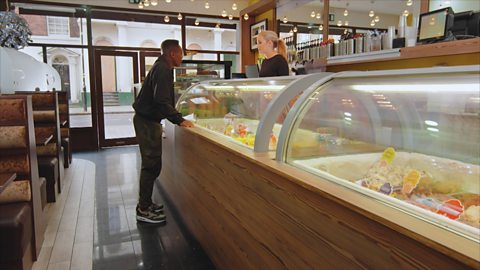SHOPKEEPER:Hi. Do you need any help there?
NICK:Hi, yeah, I need a new phone, but I'm not exactly sure what to get.
SHOPKEEPER:Tell me what your phone needs are.
NICK:Well, just social media and a decent camera, really.
SHOPKEEPER:OK, well, with any one of these phones here, the handset is £20 with every plan, but the contracts differ, depending on what your budget is. How much are you looking to spend a month?
NICK:'I have £200 as a total budget. If M is my maximum affordable monthly payment, then the number of months of the contract multiplied by M, plus the handset cost, equals my total budget. So, if I minus 20 from both sides, I'll get 180, and if I divide both sides by 12, I'll get M equals 180 divided by 12. Therefore, M would give me 15.'
NICK:I can do £15 a month.
SHOPKEEPER:For £15 a month I can give you the Anytime plan or the Anytime Plus.
NICK:What is the Anytime Plus?
SHOPKEEPER:It's the Anytime plan, plus texts.
NICK:Sorry, texts are extra?
SHOPKEEPER:No, the extra texts are on the Text Extra plan.
NICK:So, for 4GB of data…
SHOPKEEPER:I'm afraid you don't actually get any data with it. The data allowance simply means that you're allowed to have data. I can put you on the Anytime Super Plus With Data plan. How does that sound?
FEMALE:Wait, let's get some popcorn.
NICK:The film's gonna be starting soon, we're already late.
FEMALE:We've got plenty of time, there'll be another 10 minutes of adverts. How much is the popcorn? It doesn't say anywhere.
NICK:Look, there's an offer. Two drinks and a large popcorn for £6.50. We can do that and we can share the popcorn.
FEMALE:I don't think so. Your idea of sharing is hogging all of it through the entire film.
NICK:Yes, but think of all the calories. Oh, I'm gonna miss the trailers.
FEMALE:Hang on, I can work this out. There's a family deal. Four drinks and three large popcorn for £16.50.
FEMALE:'So I have two equations. If P represents popcorn, and D represents drinks, then 4D plus 3P is £16.50. 2D plus P is £6.50. Now I need to create a common term in each equation. So if I multiply the second equation by two, I will have 4D in both. So 4D plus 2P equals 13. Now if I subtract the second equation from the first,'
FEMALE:'I will cancel out D. so, zero plus P equals £3.50. So one popcorn is £3.50. Now if I substitute this back into one of my original equations, I have 2D plus 3.50 equals 6.50. Minus 3.50 from both sides, 2D equals 3. Divided by two on both sides, one drink costs £1.50.'
FEMALE:OK, I've figured it out. Nick?
A man is trying to work out how much he can afford to pay for his mobile phone contract, taking into account handset, call plan, text messages and data.
He uses an algebraic formula to determine affordability.
A couple are at the cinema, but there are no prices on the popcorn and drinks.
The woman forms and solves simultaneous equations to work out how much each costs.
This is from the series: Real Life Maths
Teacher Notes
The video can be featured in the classroom to strengthen the learner’s key skills to solve linear equations by way of balance and inverse / addition.
Learners in groups could investigate the affordability of various mobile phone deals and what are the best options according to a given budget and lifestyle and showcase a presentation of their findings.
Learners in groups could set up their cab company and using maps and scales calculate the costing’s of certain routes, factoring fuel charges and profitability using equations to substitute values.
Carousel lesson - Each table is given several questions to complete in a given set time to find two unknowns using simultaneous equations, and rotate the groups until all students have accessed all the questions.
The questions could vary from postage stamps, production items on a production line; such as the price of nuts and bolts, forming and solving simultaneous equations.
Curriculum Notes
This clip will be relevant for teaching Maths at KS3/GCSE in England Wales and Northern Ireland. Also at National 4, 5 and Higher in Scotland.
This topic appears in OCR, Edexcel, AQA, WJEC in England and Wales, CCEA GCSE in Northern Ireland and SQA in Scotland.
Sequences. video
The purchasing of cupcakes is used to explain linear and quadratic sequences.

Pythagoras. video
Cleaning a window and installing a TV are used to explain the theory of Pythagoras.

Probability. video
Predicting the weather and choosing a chocolate are used to explain probability.

Ratio and Proportion. video
A cake company demonstrates how ratios and proportions are used to complete an order.

Percentages. video
Clothes shopping and video statistics are used to explain percentages.

Trigonometry. video
A hiker trying to work out the height and distance he's walked uses trigonometry.

Fractions. video
A group of friends sharing a meal is used to explain fractions.

Geometry. video
A clothes designer trying to make an outfit uses geometry.

Finance. video
A man buying a car uses financial planning and investment to work out how much he'll pay.

Ratio and Proportion. video
A cake company demonstrates how ratios and proportions are used to complete an order.
